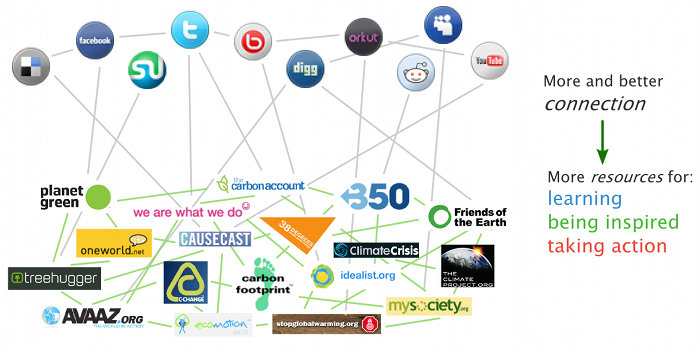Stories from the user's perspective
PePol will bring people together from different networks that were otherwise disconnected, making new things possible.

Here are some examples of how it could work for you:
example 1 - three people who were meant to meet:
Three people, Bob, Sally and John are each members of different online social networks, X, Y and Z. X, and Y are orientated towards sustainable living and addressing climate change, like OneWorld, 350 or CauseCast. Z is more of a general purpose social network, like Facebook or MySpace.
Bob has a couple of evenings spare in which he'd like to contribute to the community in a way that helps it become more sustainable. He has considerable knowledge about low carbon footprint alternatives to running a home and is a very enthusiastic person when it comes to sharing understanding. Sally, also has a couple of evenings spare and would like to know more about what she can do to live more sustainably and maybe start up a local group to support other people in this way. John, is interested in making some kind of contribution to his community, but he doesn't have much spare time. He does have access to a large meeting space though, that he would be willing to lend to activities promoting sustainable living.
It so happens that Bob, Sally and John all live within easy bus or cycling distance from each other. However, because they all use different online social networks, which are effectively isolated from each other, they are not aware of each other's existence. Bob and Sally tried putting an ad in the local paper, but the ads ran on different weeks and they missed each other. Bob searched network X and Sally searched network Y but either there was no-one registered with similar interests in their area, or the event/people search tools were hard to use and couldn't be searched by geographic location. John tried posting a notice on network Z for his meeting space, but got no responses for the type of usage he intended to make it available for. So, nothing much happens.
the PePol effect:
Now, X and Y become PePol participant networks and an extension interface is written for Z so it's users can access PePol tools too. Now when Bob searches for 'sustainable living support group' in network X, the PePol service finds the event notice that Sally posted in network Y, and knows it's in his area. In fact, because he opted to be notified of local events on this subject, he automatically gets a notice in his PePol channel when he next logs on (or straight away in his RSS reader, if he enabled that option, or email account) -he doesn't even need to search. Similarly John, finds the PePol App and adds it to his profile. He decides to post a notice about his venue. Now when Sally searches for a local venue for her group on Y she finds John's notice, through the PePol service, and so the local group is formed, because resources are pooled and the gaps between existing networks are bridged.
Many other scenarios can be imagined, for instance, Anna is a member of X, Y and Z...
example 2 - saving active people time and energy:
Anna, a member of networks: X, Y and Z, takes part in a lot of local activities with a sustainable living bias and likes to involve as many people as possible. But it's a pain to keep having to check and update all 3 (or more) networks separately.
the PePol effect:
With X, Y and Z becoming connected to the PePol service she can now create an event, publish an article or post a notice/status update and have it broadcast to all her contacts in X, Y, Z, or to selected subsets of people within those networks - all with a single action using the PePol tools. That's a lot more convenient and a lot of time saved.
This is just the tip of the iceberg, so to speak. We are currently investigating ways of organically aiding the formation of larger and more complex structures of cooperation between users, groups or organizations.
Aside from these examples of helping people who are already motivated, there is also the knock-on effect of better connectivity between such individuals and groups. More people taking action will make it easier for those people who currently only contemplate the issues of sustainability, feeling the occasional pang of guilt for not doing much about it, to learn and get the encouragement they need. When this starts happening, social norms start changing.
